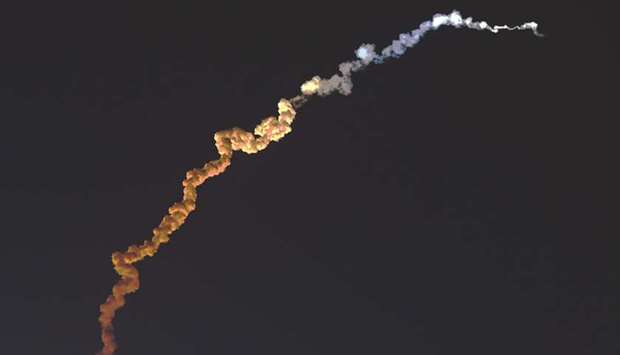India yesterday successfully placed into orbit radar imaging earth observation satellite RISAT-2B, the third in the RISAT series – after RISAT-2 and RISAT-1.
Over 5,000 visitors watched the early morning launch from the viewers’ gallery here.
The new all-weather earth observation satellite with synthetic aperture radar (SAR) will send good clarity images for use in agriculture, forestry and disaster management support, Indian Space Research Organisation (ISRO), the country’s space agency, said.
The images captured by the satellite will also be used for surveillance purposes, though the ISRO is silent on this aspect.
At 5.30am, the PSLV rocket standing around 44.4m tall and weighing about 190 tonnes with a one-way ticket hurtled itself towards the sky ferrying the 615kg RISAT-2B.
With the fierce orange flame at its tail lighting up the morning sky, the rocket slowly gathered speed and went up and up enthralling the people at the rocket port. The rocket’s engine noise like a rolling thunder added to the thrill.
About 15 minutes into the flight the rocket ejected RISAT-2B into about 555km orbit.
Speaking about the successful satellite launch, ISRO chairman K Sivan, said: “I am extremely happy to announce that PSLV-C46 has successfully injected RISAT-2B in precise orbit.” He said with this mission, the PSLV rocket has crossed a landmark of lofting of 50 tonnes since it started flying.
According to Sivan, the PSLV rocket has so far put into orbit 354 satellites, including those by India, foreign countries and students.
The PSLV rocket is a major foreign exchange earner for Antrix Corporation - the commercial arm of the ISRO.
The PSLV is a four-stage engine expendable rocket with alternating solid and liquid fuel. In its normal configuration, the rocket will have six strap-on motors hugging its first stage.
But the 44.4m tall PSLV rocket that lifted off with RISAT-2B yesterday was the ‘core alone’ variant – without the strap-on motors. The Indian space agency has PSLV variants with two and four strap-on motors and larger PSLV-XL.
Sivan said: “The rocket had a piggyback payload, the indigenously developed Vikram computer chip that will be used in future rockets.” The chip was developed by Semi-Conductor Laboratory (SCL) in Chandigarh and worked perfectly, he added.
According to the ISRO chief, RISAT-2B is an advanced Earth Observation satellite with an advanced technology of 3.6m radial rib antenna.
He said ISRO’s next major mission will be Chandrayaan-2 or the second moon mission, which is expected to take place between July 9 and 16 this year, with an expected Moon landing on September 6.
Following that will be the launch of a high-resolution cartography satellite and also the ISRO’s new rocket called the Small Satellite Launch Vehicle (SSLV).
Earlier a senior official, preferring anonymity, told IANS: “There is an increased demand for satellites from strategic sectors. About six/seven satellites are planned to be built.” The choice of the rocket to be used for a mission depends on the weight of the satellite and the orbit where the satellite has to be orbited.
The ISRO will be launching another radar imaging satellite – RISAT-2BR1 – and two more defence satellites sometime in July or August with its new rocket Small Satellite Launch Vehicle (SSLV).

The Indian Space Research Organisation’s Polar Satellite Launch Vehicle (PSLV-C46) launches on board radar imaging earth observation satellite RISAT-2B from Satish Dhawan Space centre in Sriharikota yesterday.
